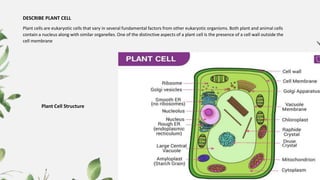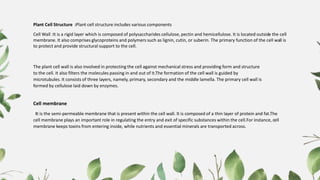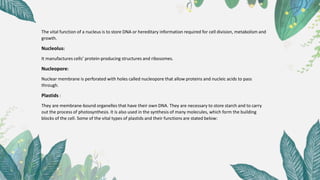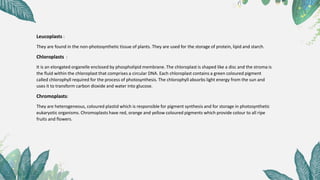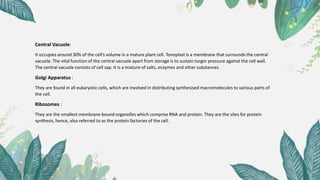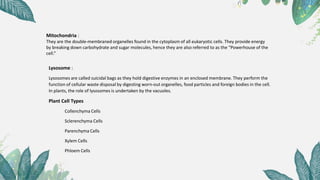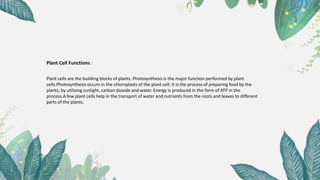PLANT CELL.pptx
- 1. PLANT CELL By: Javeria sarwar Zoologist
- 2. DESCRIBE PLANT CELL Plant cells are eukaryotic cells that vary in several fundamental factors from other eukaryotic organisms. Both plant and animal cells contain a nucleus along with similar organelles. One of the distinctive aspects of a plant cell Is the presence of a cell wall outside the cell membrane Plant Cell Structure
- 3. Plant Cell Structure :Plant cell structure includes various components Cell Wall :It is a rigid layer which is composed of polysaccharides cellulose, pectin and hemicellulose. It is located outside the cell membrane. It also comprises glycoproteins and polymers such as lignin, cutin, or suberin. The primary function of the cell wall is to protect and provide structural support to the cell. The plant cell wall is also involved in protecting the cell against mechanical stress and providing form and structure to the cell. It also filters the molecules passing in and out of it.The formation of the cell wall is guided by microtubules. It consists of three layers, namely, primary, secondary and the middle lamella. The primary cell wall is formed by cellulose laid down by enzymes. Cell membrane It is the semi-permeable membrane that is present within the cell wall. It is composed of a thin layer of protein and fat.The cell membrane plays an important role in regulating the entry and exit of specific substances within the cell.For instance, cell membrane keeps toxins from entering inside, while nutrients and essential minerals are transported across.
- 4. The vital function of a nucleus is to store DNA or hereditary information required for cell division, metabolism and growth. Nucleolus: It manufactures cellsŌĆÖ protein-producing structures and ribosomes. Nucleopore: Nuclear membrane is perforated with holes called nucleopore that allow proteins and nucleic acids to pass through. Plastids : They are membrane-bound organelles that have their own DNA. They are necessary to store starch and to carry out the process of photosynthesis. It is also used in the synthesis of many molecules, which form the building blocks of the cell. Some of the vital types of plastids and their functions are stated below:
- 5. Leucoplasts : They are found in the non-photosynthetic tissue of plants. They are used for the storage of protein, lipid and starch. Chloroplasts : It is an elongated organelle enclosed by phospholipid membrane. The chloroplast is shaped like a disc and the stroma is the fluid within the chloroplast that comprises a circular DNA. Each chloroplast contains a green coloured pigment called chlorophyll required for the process of photosynthesis. The chlorophyll absorbs light energy from the sun and uses it to transform carbon dioxide and water into glucose. Chromoplasts: They are heterogeneous, coloured plastid which is responsible for pigment synthesis and for storage in photosynthetic eukaryotic organisms. Chromoplasts have red, orange and yellow coloured pigments which provide colour to all ripe fruits and flowers.
- 6. Central Vacuole: It occupies around 30% of the cellŌĆÖs volume in a mature plant cell. Tonoplast is a membrane that surrounds the central vacuole. The vital function of the central vacuole apart from storage is to sustain turgor pressure against the cell wall. The central vacuole consists of cell sap. It is a mixture of salts, enzymes and other substances. Golgi Apparatus : They are found in all eukaryotic cells, which are involved in distributing synthesised macromolecules to various parts of the cell. Ribosomes : They are the smallest membrane-bound organelles which comprise RNA and protein. They are the sites for protein synthesis, hence, also referred to as the protein factories of the cell.
- 7. Mitochondria : They are the double-membraned organelles found in the cytoplasm of all eukaryotic cells. They provide energy by breaking down carbohydrate and sugar molecules, hence they are also referred to as the ŌĆ£Powerhouse of the cell.ŌĆØ Lysosome : Lysosomes are called suicidal bags as they hold digestive enzymes in an enclosed membrane. They perform the function of cellular waste disposal by digesting worn-out organelles, food particles and foreign bodies in the cell. In plants, the role of lysosomes is undertaken by the vacuoles. Plant Cell Types Collenchyma Cells Sclerenchyma Cells Parenchyma Cells Xylem Cells Phloem Cells
- 8. Plant Cell Functions : Plant cells are the building blocks of plants. Photosynthesis is the major function performed by plant cells.Photosynthesis occurs in the chloroplasts of the plant cell. It is the process of preparing food by the plants, by utilising sunlight, carbon dioxide and water. Energy is produced in the form of ATP in the process.A few plant cells help in the transport of water and nutrients from the roots and leaves to different parts of the plants.
- 9. Thanks G A N X I E G U A N K A N S E P T E M B E R x x x x x

